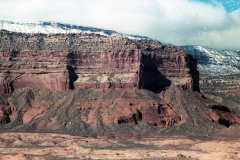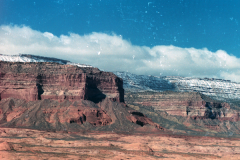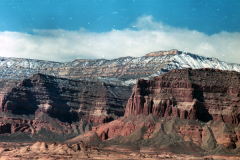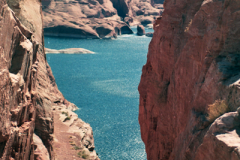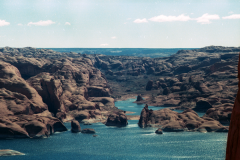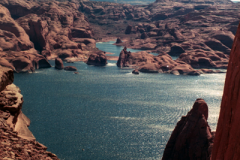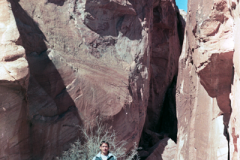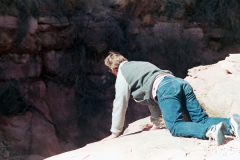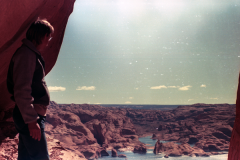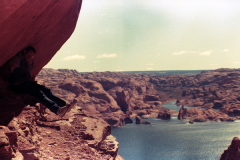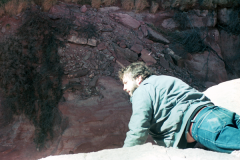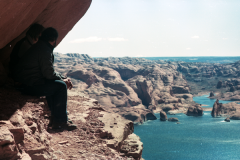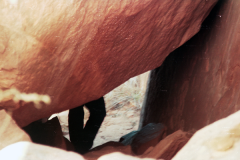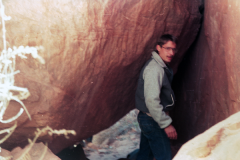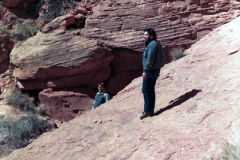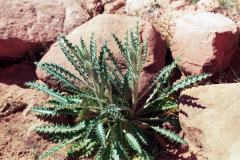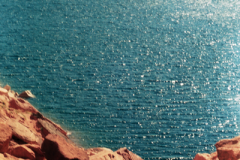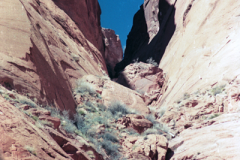We stumbled onto this place in the ’80s as Utah State University students looking for outdoor adventure. Our appetites had been whetted by taking backpacking and hiking classes, so we got out the maps. At first glance, we realized we were centrally located to access some of the best outdoor experiences in the lower 48.
We got to southern Utah in bad weather, rain, blowing wind and sand, dark. Putting up our tents by car light, a night’s sleep was afforded. I can remember, almost dreaming, about waking up and seeing the other tent floating on the lake below with two heads sticking out, after being blown over the rim and onto the lake – bobbing in the waves, waving, smiling.
On waking up, there it was, right in front of us, the start of the Hole In The Rock trail in one beautiful piece of country. Before we stared energy was needed. We had the fixins for hot breakfast but no camp stove. There seemed to be nothing to build a campfire with but sagebrush and rock. From anthropology classes I could see there was fuel for cooking. We were in a range cattle grazing area where fuel was actually abundant. I looked at the fellas and said “Lets eat breakfast!” Of course I got the look of crazy, “What’s he know that we don’t?” kinda thing. After arranging some rocks around a small hole in the ground, we all gathered some loose brush, sticks, burnables. The question on their faces was evident – Where’s the main fuel. This ain’t gonna cook much. I reached a short distance and picked up a nice dry cow pie and crumbled it onto the sticks and brush, lit the mix, and went to gather some more pies. After adding some of these gathered dried pies, in a short time there was a clean, white ashen, outdoor cooker waiting to do our bidding.
Hole-in-the-Rock Expedition
The Mormon expedition to colonize the San Juan area in the four corners of the United States is a feat unparalleled in American colonization. The Hole-in-the-Rock colonists literally carved out a wagon trail through present-day Grand Staircase-Escalante, crossed the Colorado River and Grey Mesa, and then up San Juan Hill to reach the area of present-day Bluff, Utah. The roughly two hundred and fifty mile Hole-in-the-Rock Trail took the Mormon pioneers over six months to complete.
The Mormon Church wanted to settle the San Juan area in part to protect southern Utah settlements from non-Mormons, outlaws, and to create better relations with the Indians so they could better take over their lands.
April 13, 1879, Silas Smith and an exploratory party left Paragonah (near Cedar City, Utah) to blaze a trail to the four-corners area of the San Juan River The exploratory party consisted of twenty-six men, two women, eight children, eight wagons, eighty horses, and sixty-six head of cattle–two of the members were Jens Nielson’s son Joe and his son-in-law Kumen Jones. The two families with the party intended to settle on Montezuma Creek just above where it emptied into the San Juan River.
This story can be found at http://www.thefurtrapper.com/Hole_Rock.htm
This was the start of the expedition to cross what was then a canyon similar to the Grand Canyon further south.
The photographs here are taken at the very spot the Mormons crossed. Lake Powell is a reservoir on the Colorado River, straddling the border between Utah and Arizona (most of it, along with Rainbow Bridge, is in Utah). It is a major vacation spot that around 2 million people visit every year. It is the second largest man-made reservoir, by maximum water capacity, in the United States behind Lake Mead, storing 24,322,000 acre feet (3.0001×1010 m3) of water when full. Lake Powell was created by the flooding of Glen Canyon by the controversial Glen Canyon Dam, which also led to the creation of Glen Canyon National Recreation Area, a popular summer destination. The reservoir is named for explorer John Wesley Powell, a one-armed American Civil War veteran who explored the river via three wooden boats in 1869. In 1972, Glen Canyon National Recreation Area was established. It is public land managed by the National Park Service, and available to the public for recreational purposes. It lies in parts of Garfield, Kane, and San Juan counties in southern Utah, and Coconino County in northern Arizona. The northern limits of the lake extend at least as far as the Hite Crossing Bridge.
Lake Powell is a reservoir on the Colorado River, straddling the border between Utah and Arizona (most of it, along with Rainbow Bridge, is in Utah). It is a major vacation spot that around 2 million people visit every year. It is the second largest man-made reservoir, by maximum water capacity, in the United States behind Lake Mead, storing 24,322,000 acre feet (3.0001×1010 m3) of water when full. Lake Powell was created by the flooding of Glen Canyon by the controversial Glen Canyon Dam, which also led to the creation of Glen Canyon National Recreation Area, a popular summer destination. The reservoir is named for explorer John Wesley Powell, a one-armed American Civil War veteran who explored the river via three wooden boats in 1869. In 1972, Glen Canyon National Recreation Area was established. It is public land managed by the National Park Service, and available to the public for recreational purposes. It lies in parts of Garfield, Kane, and San Juan counties in southern Utah, and Coconino County in northern Arizona. The northern limits of the lake extend at least as far as the Hite Crossing Bridge.
Lake Powell is a storage facility for the Upper Basin states of the Colorado River Compact (Colorado, Utah, Wyoming, and New Mexico). The Compact specifies that the Upper Basin states are to provide a minimum annual flow of 7,500,000 acre feet (9.3 km3) to the Lower Basin states (Arizona, Nevada, and California).
History
In the 1940s and early 1950s, the U.S. Bureau of Reclamation planned to construct a series of Colorado River dams in the rugged Colorado Plateau province of Colorado, Utah and Arizona. Glen Canyon Dam was born of a controversial damsite the Bureau selected in Echo Park, in what is now Dinosaur National Monument in Colorado. A small but politically effective group of objectors led by David Brower of the Sierra Club succeeded in defeating the Bureau’s bid, citing Echo Park’s natural and scenic qualities as too valuable to submerge.
But by agreeing to a relocated damsite near Lee’s Ferry, between Glen and Grand Canyons, Brower did not realize what he had gambled away. At the time, Brower had not actually been to Glen Canyon. When he later saw Glen Canyon on a river trip, Brower discovered that it had the kind of scenic, cultural, and wilderness qualities often associated with America’s national parks. Over 80 side canyons in the colorful Navajo Sandstone contained clear streams, abundant wildlife, arches, natural bridges, and thousands of Native American archeological sites.[citation needed] By then, however, it was too late to stop the Bureau and its commissioner Floyd Dominy from building Glen Canyon Dam. Dominy was a firm believer in putting the river to human use, once saying “Now I admit that nature can’t improve upon man. We’re probably the supreme being.” Brower believed the river should remain free, and would forever after consider the loss of Glen Canyon his life’s ultimate disappointment.
Construction on Glen Canyon Dam began with a demolition blast keyed by the push of a button by President Dwight D. Eisenhower at his desk in the Oval Office on October 1, 1956. The first blast started clearing tunnels for water diversion. On February 11, 1959, water was diverted through the tunnels so dam construction could begin. Later that year, the bridge was completed, allowing trucks to deliver equipment and materials for the dam, and also for the new town of Page, Arizona.
Concrete placement started around the clock on June 17, 1960. The last bucket of concrete was poured on September 13, 1963. Over 5 million cubic yards (4,000,000 m³) of concrete make up Glen Canyon Dam. The Dam is 710 feet (216 m) high, with the surface elevation of the water at full pool being approximately 3700 feet (1100 m). Construction of the Dam cost $155 million, and 18 lives were lost in the process. From 1970 to 1980, turbines and generators were installed for hydroelectricity. On September 22, 1966, Glen Canyon Dam was dedicated by Lady Bird Johnson.
Upon completion of Glen Canyon Dam on September 13, 1963, the Colorado River began to back up, no longer being diverted through the tunnels. The newly flooded Glen Canyon formed Lake Powell. It took 11 years for the lake to rise to the high-water mark, on June 22, 1980. Since then the lake level has fluctuated considerably depending on the seasonal snow runoff from the mountains.
Colorado River flows have been below average since the year 2000, leading to lower lake levels. In the winter of 2005 (before the spring run-off) the lake reached its lowest level since filling, an elevation of 3,550 feet (1,080 m) above sea level, which was approximately 150 feet (46 m) below full pool (elevation 3700′). Since 2005 the lake level has risen 78 feet (24 m), to a high elevation of 3,628 feet (1,106 m) above sea level in spring/early summer 2008. However, 2011 saw the third largest June and the second largest July runoff since the closure of Glen Canyon Dam, and the water level peaked at nearly 3,661 feet (1,116 m) on July 30.
In water year 2013, Lake Powell is experiencing a second consecutive year of low inflows, with only a brief period of refill in late May and June pushing the lake level up 5 feet before outflows again began outpacing inflows.
Geology
Glen Canyon was carved by differential erosion from the Colorado River over an estimated 5 million years. The Colorado Plateau, through which the canyon cuts, arose some 11 million years ago. Within that plateau lie layers of rock from over 300 million years ago to the relatively recent volcanic activity. Pennsylvanian and Permian formations can be seen in Cataract Canyon and San Juan Canyon. The Moenkopi Formation, which dates from 230 million years ago (Triassic Period), and the Chinle Formation are found at Lees Ferry and the Rincon. Both formations are the result of the ancient inland sea that covered the area. Once the sea drained, windblown sand invaded the area, creating what is known as Wingate Sandstone. The more recent (Jurassic Period) formations include Kayenta Sandstone, which produces the trademark blue-black “desert varnish” that streaks down many walls of the canyons. Above this is Navajo Sandstone, the result of more compressed sand dunes. Many of the arches, including Rainbow Bridge, lie at this transition point. This period also includes light yellow Entrada Formations, and the dark brown, almost purple Carmel Formation. These latter two can be seen on the tops of mesas around Wahweap, and the crown of Castle Rock and Tower Butte. Above these layers lie the Straight Cliffs Sandstone and conglomerate shales that make up the Kaiparowits Plateau and San Rafael Swell to the north of the lake.
The confluences of the Escalante, Dirty Devil and San Juan Rivers with the Colorado lie within Lake Powell. The slower flow of the San Juan river has produced goosenecks where 5 miles (8.0 km) of river are contained within 1-mile (1.6 km) on a straight line.
Glen Canyon Dam is a concrete arch dam on the Colorado River in northern Arizona in the United States, near the town of Page. The dam was built to provide hydroelectricity and flow regulation from the upper Colorado River Basin to the lower. Its reservoir is called Lake Powell, and is the second largest artificial lake in the country, extending upriver well into Utah. The dam is named for Glen Canyon, a colorful series of gorges, most of which now lies under the reservoir.
The dam was proposed in the 1950s as part of the Colorado River Storage Project, a U.S. Bureau of Reclamation (USBR) federal water project that would develop reservoir storage on the upper Colorado River and several of its major tributaries. The project’s main purpose was to allow the upper basin to better utilize its allocation of river flow as designated in the 1922 Colorado River Compact, and as to provide water storage to ensure the delivery of sufficient water to the lower basin during years of drought. However, problems arose when the USBR proposed to build dams in the federally protected Echo Park canyon in Utah. After extensive policy disputes and legal challenges with environmental organizations such as the Sierra Club, they settled for a high dam at Glen Canyon.
Construction of Glen Canyon Dam started in 1956 and was not finished until 1966. When the reservoir filled, the dam began to deliver a regulated flow of water downstream and a supply of electricity to the region. In 1983, major floods nearly led to the dam’s collapse, but disaster was averted by a close margin. By suppressing floods and other factors that once characterized the Colorado, the dam has led to major physical and ecological changes in the lower river. Controversy continues over the effects both positive and negative of the dam, which has also been antagonized in many literary works.
Glen Canyon’s design was overall based on that of Hoover Dam, a massive concrete arch-gravity structure anchored in solid bedrock, with several changes. The engineers wanted the dam to rely predominantly on its arch shape to carry the tremendous pressure of the impounded water into the canyon walls instead of depending on the sheer weight of the structure to hold the reservoir back, as had been done at Hoover. However, most of the rock in the region consists of porous and relatively weak Navajo sandstone in contrast to the stronger rock at the Hoover Dam site, forcing the Glen Canyon design to follow more conservative lines by greatly thickening the abutments, thus increasing the surface area through which the weight of dam and reservoir would be transmitted to the rock and relieving the pressure per square inch on the highly breakable cliffs. The primary designer and overseer of construction was veteran Reclamation engineer Lem F. Wylie, who had worked on the Hoover Dam project and had been chief engineer of six other USBR dams.[23][citation needed]
Before building the dam, Reclamation identified two possible sites, both located in the narrow lower reaches of Glen Canyon shortly upstream of Lee’s Ferry. One, just 4 miles (6.4 km) upstream, was originally considered the superior site, but the final decision was to build the dam 16.5 miles (26.6 km) upstream because of stronger rock and easier access to the gravel mining area at the confluence of Wahweap Creek with the Colorado.[24] The dam site lay in a remote, rugged area of the Colorado Plateau, more than 30 miles (48 km) from the closest paved road, U.S. Highway 89, and a whole new road had to be constructed, branching off from Highway 89 north of Flagstaff, Arizona, and running through the dam site to its terminus at Kanab, Utah.[25] Because of the isolated location, acquiring the land at the dam and reservoir sites was not incredibly difficult, but still conflicts arose with the ranchers and miners in the area (many of the Navajo tribe).[19] Much of the land acquired for the dam was through an exchange with the Navajo, in which the tribe ceded Manson Mesa south of the dam site for a similar-sized chunk of land in New Mexico, which the Navajo had long coveted.
Glen Canyon damsite from the air in November 1957, prior to construction of the Glen Canyon Bridge
As a road link was obviously needed for transport across the canyon from one end of the dam site to the other, a bridge had to be built, several hundred feet downstream of the dam and capable of carrying not only workers but heavy construction material. An earlier footbridge built of chicken wire and metal grates certainly did not fit the bill. The contract for building the bridge was awarded to Peter Kiewit Sons and the Judson Pacific Murphy Co. for $4 million and construction began in late 1956, reaching completion on August 11, 1957.[26] When finished, the Glen Canyon Bridge was in itself a marvel of engineering: 1,271 feet (387 m) long and rising 700 feet (210 m) above the river, it was the highest bridge of its kind in the United States and one of the highest in the world. By 1959, the bridge itself was a major tourist attraction and it was said that “motorists [were] driving miles out of their way just to be thrilled by its dizzying height”.[27]
Workers flooded into the dam site beginning in the mid-late 1950s, and the construction camp started out as a haphazardly organized trailer park that grew with the workforce.[28] During the construction of the Glen Canyon Bridge, Reclamation also began planning a company town to house the workers. This resulted in the town of Page, Arizona, named for former Reclamation commissioner John C. Page. By 1959, Page had a host of temporary buildings, electricity, and a small school serving the workers’ children. As the city grew, it gathered additional features, including numerous stores and a hospital, even a jeweler’s.[26] It was intended to serve a maximum population of eight thousand, accounting for the workers’ families; the peak workforce would eventually exceed 2,500 in the busiest phases of construction.[29]
River diversion[edit]
In 1956, work began on the two diversion tunnels that would carry the Colorado River around the dam site during construction. Each of the tunnels was 2,700 feet (820 m) long and 41 feet (12 m) in diameter, and had a combined capacity of 200,000 cubic feet per second (5,700 m3/s).[30] The diversion tunnel at river right would be used for carrying the river’s normal flow around the dam site, while the left tunnel, 33 feet (10 m) above the water, would only be used during floods. The lower reaches of the tunnels would later be used to form the lower ends of the dam’s spillways.[31] On October 15, 1956, President Dwight D. Eisenhower pressed a button on his desk in the capital of Washington D.C., sending a telegraph signal that set off the first blast of dynamite at the portal of the right diversion tunnel.[32] Drilling the tunnels through the porous Navajo sandstone abutting the dam site posed major problems for the excavation crews of the Mountain States Construction Company, which won the contract for the diversion tunnels in 1956.[33]
First, transporting workers and equipment to the bottom of the canyon was extremely difficult. Initially, transport was done by barge from the Wahweap Creek gravel deposits shortly upstream, but this was dangerous and was replaced by a vertical cable system when a barge capsized, spilling tons of machinery into the river.[34] The geology of the area also posed problems. During excavation, the rock frequently broke apart or “slabbed” and collapsed into the tunnels, and metal bolts had to be drilled into the rock to secure it. The largest such event, on August 5, 1958, sent 5,200 cubic yards (4,000 m3) crashing down onto the upper portal of the left diversion tunnel. Material excavated out of the tunnels and excavations for the dam abutments on the canyon walls was used to build the two cofferdams that would keep the damsite dry during construction of the dam itself, the last of which was finished in February 1960. The upstream cofferdam was 168 feet (51 m) high, and it alone could store several million acre-feet of water to protect the dam site from flooding in the event that inflows exceeded the capacity of the diversion tunnels. On February 11, 1959, the right diversion tunnel was completed and began to carry the flow of the Colorado. The left tunnel was finished over three months later on May 19, 1959, slightly behind schedule.[35]
Concrete placement and completion.
With the Colorado River safely out of the dam site, construction could begin on the actual main body of the dam. The contract was given to the Merritt-Chapman & Scott Corporation for an astonishingly low $107,955,552. Unfortunately, right before construction could start, about 750 workers organized a strike because of a wage reduction due to the completion of public facilities at Page. In late 1959, salaries were raised by $4 a day, quelling the strikers. Concrete placement started on June 16, 1960, and started at a sluggish but growing pace. In 1962 the workforce topped out at nearly 2,500 employees laboring on the dam.[36] Construction would ultimately claim eighteen lives and injure numerous other workers, but contrary to popular myth, no workers were buried alive in the concrete. Cement needed to make concrete for the dam came from the Phoenix Cement Company plant constructed for the purpose in Clarkdale, south of Flagstaff.
Architectural plans for the Glen Canyon Dam and ancillary structures
A huge concrete plant capable of putting out 1,450 tons per hour was installed, and a pair of cableways with movable towers with capacities of 50 and 25 tons each spanned the canyon, carrying the 12 yard concrete buckets to their final destinations on the steadily rising crest of the dam. The concrete was poured into modular 7.5-foot (2.3 m) high wooden blocks or “forms”, the largest measuring up to 60 feet (18 m) by 210 feet (64 m);[37] more than 3,000 of these blocks made up the main structure of the dam. Once the concrete dried, the wooden scaffolding was removed and shifted upwards to accommodate the next load of concrete. As construction efficiency increased, the workforce slowly decreased, as new methods of transportation and placement were implemented including conveyors and remotely controlled buckets. By late 1962, concrete was being poured into the dam at a rate of 8,000 cubic yards (6,100 m3) per day even as the workforce was scaled down to about 1,500.
At the beginning of 1963, the dam was high enough to begin impounding water; huge steel gates were closed over the diversion tunnels on January 2, and Lake Powell began to rise. On that day, Sierra Club leader David Brower entered the Oval Office in a last-ditch effort to save Glen Canyon from inundation – but failed to convince the president.[40] Construction continued and on September 13, 1963, the dam was topped out.[39] Work on the power plant and spillways began directly after the dam wall was complete. The spillway tunnels were excavated around both abutments of the dam and drop steeply from their control gates on Lake Powell to merge with the lower ends of the diversion tunnels. This measure saved cost, but introduced a weak point in the spillways – the point where the spillways met the diversion tunnels now had an abrupt directional change of 55 degrees. The upper ends of the diversion tunnels were then sealed with solid concrete. The first electricity was generated on September 4, 1964, with the power sent into the regional electric grid through a pair of long-distance transmission lines as far as Phoenix, Arizona and Farmington, New Mexico.
Further information: Risks to the Glen Canyon Dam
During the first half of 1983, a deep snowpack in the Colorado River headwaters, heavy spring rain and a rapid rise in temperatures that precipitated swift snowmelt combined to create perfect conditions for maximum runoff on the Colorado River. Faulty weather forecasts delayed emergency releases from the dam to prepare for the coming high water, and by June water was pouring into the reservoir at over 120,000 cubic feet per second (3,400 m3/s). Even with the power plant and river outlet works running at full capacity, Lake Powell continued to rise to the point to which the spillways had to be opened. Other than brief tests in 1980, this was the only time the spillways had ever been used.[41]
At the beginning of June dam operators opened the gates on the left spillway, sending 10,000 cubic feet per second (280 m3/s), just 7.2% of capacity, down the tunnel into the river below. After a few days, the entire dam suddenly began to shake violently. The spillway was closed down for inspections and workers discovered that the flow of water was causing heavy cavitation – the explosive collapse of vacuum pockets in water moving at high speed – which was damaging the concrete lining and eroding the rock spillway tunnels from the upper ends of the diversion tunnels, which connect to the bottom of the reservoir. This was rapidly being destroyed by the cavitation and it was feared that a connection would be made to the bottom of Lake Powell, allowing the entire contents of the reservoir to drain into the river downstream.[42]
Right spillway gates during 1983 flood, showing flashboards that were installed to increase the water level
Meanwhile, snow continued melting in the Rockies and Lake Powell continued to rise rapidly. To delay having to use the spillways, Reclamation installed plywood flashboards (later replaced by steel) atop the gates to increase the lake level.[43] Even this additional capacity was exhausted; discharges through the left spillway reached 32,000 cubic feet per second (910 m3/s) and the right spillway gates were also opened. Flows downstream at Lee’s Ferry peaked at 97,300 cubic feet per second (2,760 m3/s), which was and still is the highest water flow recorded there since early construction work at the dam site in 1958.[44] On July 15, Lake Powell reached its highest recorded level in history. Just as it seemed inevitable that the dam would fail, inflows fell and the dam was saved. Upon inspection, it was found that cavitation had caused massive gouging damage to both spillways, carrying away thousands of tons of concrete, steel rebar and huge chunks of rock.[45]
Repairs to the spillways commenced as soon as possible and continued well into 1984. Aeration slots were installed at the bottom of each spillway to break up and absorb the shock of the bubbles formed by cavitation. In 1984, the Colorado River basin produced even more runoff than 1983, but fortunately Reclamation had drawn down the reservoir enough that it absorbed most of the early high flows. Nevertheless, Lake Powell rapidly approached the top of the spillway gates and construction efforts were subsequently focused on the left spillway in order to get it in operation in time. On August 12, the left spillway gates were opened, releasing water at a rate of 50,000 cubic feet per second (1,400 m3/s). The spillway was undamaged, proving the worth of the re-engineering and suggesting that Glen Canyon Dam will also be able to hold against future floods with the magnitude of 1983.
Continuing debates
Long after the Glen Canyon Dam was built and continuing to the present day, heated debate continues between those who believe the dam should remain in place and those who think it should be removed. “Without Glen Canyon Dam, the big sponge of Lake Powell to absorb the flood years, there’s no way that the upper basin states could put their seven and a half million acre feet of water to use. They say now of course that Glen Canyon isn’t needed, you don’t divert any water out of Lake Powell, well, you do divert water out of Lake Powell by transfer. When you divert water through the mountains in the Utah and Colorado into other uses, it’s really out of Lake Powell because it’s the big storage that’s possible there– makes possible the upper basin a development,” said Former Bureau of Reclamation Commissioner Floyd Dominy, a figure heavily associated with the building of Glen Canyon Dam and many of the other big dams built by Reclamation.[48] On the other end of the line, David Brower called the dam his worst mistake and “the biggest sin I ever committed” because of the compromise his organization made to build it instead of Echo Park.[49]
On March 21, 1981 four members of the environmental group Earth First! staged an anti-dam protest by unfurling a 300-foot (91 m) tapered black sheet of plastic down the face of the dam, making it appear as if a gigantic crack had appeared in the structure. Authorities were unable to find the individuals responsible.[50][51]
The Glen Canyon Institute and other environmental organizations continue to advocate for the decommissioning of the dam and the draining of Lake Powell.
Structure and storage
The Glen Canyon Dam impounds the Colorado River about 1 mi (1.6 km) northwest of Page in the narrow lower reach of Glen Canyon and 16.4 miles (26.4 km) upstream of Lee’s Ferry. The dam is 710 feet (220 m) high from the crest to the foundations and has a crest length of 1,560 feet (480 m). The maximum height above the river is about 583 feet (178 m).[2] Overall, the dam relies on its arched design to carry the reservoir’s weight into the canyon walls, but because of the sheer scale of the structure and the relatively weak surrounding rock, the dam has medium thickness of about 300 feet (91 m) at the widest point. The crest is 3,715 feet (1,132 m) above sea level and the river immediately downstream sits at 3,132 feet (955 m).
Two spillways and four high pressure outlet works protect the dam against floods. Located on both sides of the dam shortly upstream, the spillways are concrete-lined tunnels that drop sharply through the canyon walls abutting the dam, emptying into the lower ends of the diversion tunnels to save the expense of digging new tunnels. Each spillway is controlled by two 40-foot (12 m) long, 52.5-foot (16.0 m) high radial gates and is capable of carrying 138,000 cubic feet per second (3,900 m3/s) for a combined capacity of 276,000 cubic feet per second (7,800 m3/s). The river outlets consist of four 8-foot (2.4 m) diameter pipes each controlled by a follower gate and hollow-jet valve with a capacity of 15,000 cubic feet per second (420 m3/s).[52] Glen Canyon’s spillways were used for flood purposes only once in 1983, which caused severe damage that nearly led to dam failure (see section above).
The power plant at Glen Canyon Dam is located at the foot of the structure and contains eight 155,500 horsepower generators with a combined capacity of 1,296 megawatts (MW). Each generator is driven by a turbine which is in turn fed by a penstock with a starting diameter of 15 feet (4.6 m), narrowing to 14 feet (4.3 m) as it enters the turbines. Five generators are rated at 165 MW and the remaining three have a capacity of 157 MW each. Before an uprating project in the late 20th century, each of the generators were rated at 118.75 MW for a total of 950 MW. The maximum hydraulic head for the power plant is 510 feet (160 m). Power generated at Glen Canyon is distributed by the Western Area Power Administration.
Lake Powell is the second-largest reservoir in the United States, with a full storage capacity of some 26,214,900 acre feet (32.3356 km3). The original design storage capacity of Powell was some 27,000,000 acre feet (33 km3), but some of it has been compromised by sedimentation. At maximum pool, the reservoir reaches 186 miles (299 km) upstream to the mouth of Cataract Canyon, covering 252 square miles (650 km2) with a twisting, winding shoreline of over 2,000 miles (3,200 km). The active capacity is 20,876,000 acre feet (25.750 km3) and the inactive capacity is 4,000,000 acre feet (4.9 km3) (the lowest point where electricity can still be generated). The dead pool volume is 1,900,000 acre feet (2.3 km3), marking the lowest point where water can be released through the dam.[citation needed] Although the dam lies in northern Arizona, the vast majority of the reservoir is actually in southern Utah. Many arms branch off the lake, the longest being those formed by Wahweap Creek, Navajo Creek, Last Chance Creek, the San Juan River, the Escalante River, Halls Creek, and Bullfrog Creek. The reservoir lies mainly in the Glen Canyon National Recreation Area.
Operations
By and large, the Glen Canyon Dam’s main purpose is to fulfill the agreement in the Colorado River Compact made by the upper basin states to allow at least 7,500,000 acre feet (9.3 km3) of water to flow annually past Lee’s Ferry for use by Arizona, Nevada and California. The dam is operated to maintain a minimum annual release volume of 8,230,000 acre feet (10.15 km3) or about 11,350 cubic feet per second (321 m3/s), which is well over the amount stipulated by the compact but not enough to deliver enough water to Mexico as written in the 1944 Treaty for the Utilization of Waters of the Colorado and Tijuana Rivers and of the Rio Grande.[citation needed] Water for delivery to Mexico is provided by the additional amount released from Glen Canyon – about 730,000 acre feet (0.90 km3) in the average year – as well as tributaries entering the Colorado between Glen Canyon and Hoover Dam, as well as tributaries below Hoover, although many of those have been diverted for irrigation in central Arizona.
When the dam was first built, the set annual release volume was believed to be the minimum sustainable flow of the Colorado River past the dam site minus the Upper Basin’s allocation of 7.5 million acre feet. Reclamation’s studies suggested that the Colorado and other tributaries that feed into the reservoir, such as the San Juan and Escalante, would dump more water into the reservoir during spring runoff than could be efficiently released to maximize power generation on an average of one out of every four years, so the reservoir is operated to reach a peak annual volume of 90% of capacity during July, with power plant releases scheduled based on runoff forecasts.The 1983 and 1984 floods dramatically noted that runoff could not be predicted accurately enough all the time. Since then, even though Glen Canyon was never built for the purpose of flood control, Reclamation has maintained a minimum of 2,400,000 acre feet (3.0 km3) of flood-storage space in the reservoir (approximately 9% of Lake Powell’s capacity) to be available on January 1 of any year.[55] In the 21st century, protracted drought caused Lake Powell to drop significantly, reaching a record low of 33% full in 2005, with 2011 being the first year of relief after eight straight years of low water
The dam’s powerplant is operated as a “cash register” power station, meaning that sales of the electricity it generates was used to pay for the original construction cost and is used for maintenance needs as well as a source of revenue for the Bureau of Reclamation.[40] In fact, the primary function of the dam is power production; it wields more than 75% of the hydroelectric capacity of the entire Colorado River Storage Project. The dam also serves as a primary peaking power plant and black start power source for the electrical grid of much of the southern Intermountain West.[37][56] Colorado River flows fluctuate daily below the dam, as much as 15,000 to 22,000 cubic feet per second (420 to 620 m3/s) every 24 hours, depending on power demand.[57] Minimums may drop as low as 1,000 cubic feet per second (28 m3/s) in December and highs as much as 31,500 cubic feet per second (890 m3/s) in June and July (the full discharge capacity of the turbines).[58] In an average year, the power plant uses only about one-fourth of its full capacity,[59] producing 3.454 billion kilowatt hours (KWh) annually.[5][37] Annual power output has ranged from a high of nearly 10.4 billion KWh in 1984 to less than 2.0 billion KWh in 2002.
Environmental impact.
View of the Colorado immediately downstream of Glen Canyon Dam (right). The green, clear water is caused by the dam trapping sediment, which would naturally cause the river to have a reddish-brown color.
Because of its tremendous ecological effect on the Colorado River, the Glen Canyon Dam has inspired heavy controversy from environmentalists. Because of its location in the desert amid porous geology, Lake Powell causes huge evaporation and seepage losses. It is estimated that between 675,000 acre feet (0.833 km3) and 1,000,000 acre feet (1.2 km3), with an average of 860,000 acre feet (1.06 km3), is lost from the reservoir each year. This amounts to 6-8% of the Colorado River’s flow, an increasingly valuable amount of water in an arid land for both humans and the animals and plants that live along the river.
Like all dams, Glen Canyon traps silt, but because the Colorado is an especially high-sediment river, the dam has posed even worse consequences for the river between it and Lake Mead (essentially, the Grand Canyon). About 100 million tons of sediment are trapped behind the dam annually, equal to about 30,000 dump truck loads daily.[61] Because of the dam, sediment deposited by the Colorado and its tributaries is slowly filling up the canyon, and the most optimistic projections put the useful life of the reservoir at 300–700 years. If no action is taken such as dredging, in a few hundred years, sediment deposits will begin to build up at the foot of the dam and will gradually block the different outlets used to release water. Thus, if drought intervenes during the same period, the dam may not be able to release water due to the blockage of the river outlets and penstocks. The Colorado below the dam would be reduced to a trickle, causing unprecedented loss of riverine life.[62]
The Colorado through Grand Canyon now lacks the source of sediment it needs to build sandbars and islands, and these natural fluvial formations within the canyon have now suffered severe erosion damage. The floods that once scoured the river yearly are now contained behind the dam except in the worst cases; the elimination of this periodic scouring has promoted vegetation encroachment which not only has considerably changed the riparian zone environment but has created problems for tourism, wherein hikers and rafters often cannot find good spots to camp due to overgrowth. Flow control has also caused an inability of the river to carry away the rockslides that are common along the canyons, leading to the creation of incrementally dangerous rapids that pose a hazard to fish and boaters alike. Before the dam, the Colorado commonly reached flows of more than 90,000 cubic feet per second (2,500 m3/s) during the spring; this has been limited to less than 35,000 cubic feet per second (990 m3/s) most years with few exceptions.[63][64]
Glen Canyon, which Lake Powell flooded, was really more of a narrow and steep sided valley than a canyon and was once described as the “biological heart” of the Colorado because of its abundant riparian growth and streamside habitat on the numerous low river terraces. The canyon once supported 79 plant species, 189 bird species and 34 kinds of mammals.[65] Below the dam, the Colorado has turned into a “death zone for native fish”[66] such as the endangered humpback chub as said by Nikolai Ramsey of the Grand Canyon Trust. Throughout most of the year, water released by Glen Canyon is a consistent 47 °F (8 °C) due to a thermal mass effect in Lake Powell where the water typically released from hundreds of feet below the lake surface through the penstocks is insulated from temperature fluctuations by the thick layer of water above it. Pre-dam, the river ranged from over 80 °F (27 °C) in the heat of summer to just above 32 °F (0 °C) in winter.[67]
In addition to the effect this has on native fish species, biologist and veteran river guide Michael P. Ghiglieri proposed many drowning deaths by boaters in the Grand Canyon Colorado have been caused or exacerbated by rapid hypothermia and hypothermic shock caused by entering the cold water. He further noted during the record post-dam high-flow season of 1983 (mentioned above), there was only one boating fatality in the canyon, providing a strong challenge to views that the dam, by reducing and mediating river flows, increases the safety of canyon river users. The river water temperature in 1983 was significantly higher than normal, due to a large portion of the water having come from overflows of warmer surface water over the spillways of Glen Canyon Dam, rather than the colder lower levels which feed the penstocks.[68]
Restoration efforts[edit]
On March 26, 1996, the penstocks and two of the outlet works’ bypass tubes at Glen Canyon Dam were opened to maximum capacity, producing a flood crest of about 45,000 cubic feet per second (1,300 m3/s) on the Colorado River. This was not due to any flood or mechanical failure, but rather was a controlled effort to assist the recovery of the damaged riverine ecosystem by mimicking the spring freshets that once swept through the canyons yearly. The flow appeared to have scoured clean numerous pockets of encroaching vegetation, carried away rockslides that had become dangerous to boaters, and rearranged sand and gravel bars along the river, and was considered an environmental success.[69][70]
Contrary to the initial results, the following years revealed that the offensive vegetation had not been carried away as previously thought – only buried, and had mostly recovered within six months. The surface area of sandbars had been increased, but much of the material had been eroded from the submerged portions of the bars and deposited on top, making them unstable, rather than scoured from the riverbed as hoped. Reclamation has repeated the floods periodically, another time in 2004, 2008, and again in 2012.
Nevertheless, some continue to believe that the dam has too large and severe of an effect on the river’s ecology to make restoration efforts worthwhile.
Recreation
Lake Powell is one of the most popular houseboating and water-skiing areas in the United States; the Glen Canyon National Recreation Area, which surrounds the reservoir, receives more than 1.9 million visitors annually.
About 300,000 of these tourists travel via boat to Rainbow Bridge in Utah, a large natural arch once very hard to access, but now easily reachable because one of the arms of the reservoir extends near it.
Glen Canyon National Recreation Area draws more than two million visitors annually. Recreational activities include boating, fishing, waterskiing, jet-skiing, and hiking. Prepared campgrounds can be found at each marina, but many visitors choose to rent a houseboat or bring their own camping equipment, find a secluded spot somewhere in the canyons, and make their own camp (there are no restrictions on where visitors can stay).
Currently most Marinas on the lake don’t have Automatic Identification System monitoring stations that transmit boat positions to the AIS websites for the boating community. A substantial number of vessels on the lake do not have AIS transponders, so extra precautions must be taken with respect to boating safety. The telemetry system used to monitor the hydrologic activity of the lake by the federal government agencies in charge of the dam does not at this point support AIS monitoring, creating an additional safety gap.
Because most of the lake is surrounded by steep sandstone walls, access to the lake is limited to developed marinas:
1. Lee’s Ferry Subdistrict
2. Page/Wahweap Marina
3. Antelope Point Marina
4. Halls Crossing, Utah Marina
5. Bullfrog Marina
6. Hite Marina
The following marinas are accessible only by boat:
1. Dangling Rope Marina
2. Rainbow Bridge National Monument
3. Escalante Subdistrict
In popular culture
* Edward Abbey’s novel The Monkey Wrench Gang describes the fictional efforts of a group of environmentalists who fantasize about blowing up the dam.
* In detective novel Wet Desert by Gary Hansen, the Glen Canyon Dam is destroyed by environmental terrorists.
* The dam was used as a location in the 2011 Doctor Who episode “Day of the Moon”.
* The dam was used as a location in the television cult classic, Route 66 . “Layout at Glen Canyon” (episode 9, season 1) was broadcast December 2, 1960.

